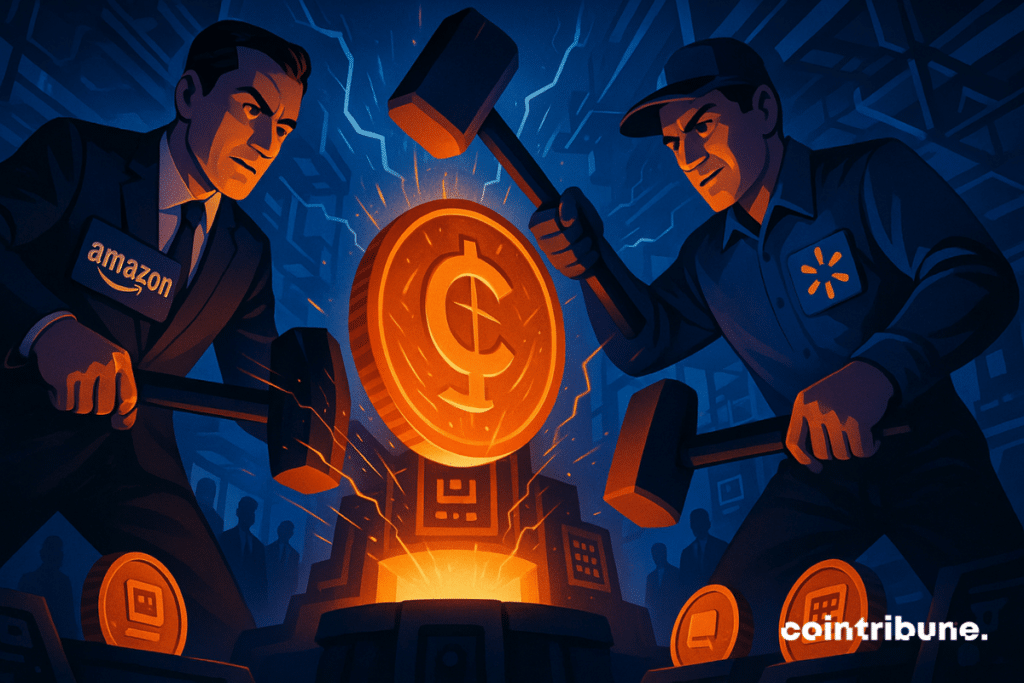Amazon And Walmart Dive Into The World Of Stablecoins
The American retail giants, Amazon and Walmart, are currently exploring the issuance of their own dollar-backed stablecoins. This initiative, still in the exploratory phase, could eventually disrupt the online payments landscape and further strengthen the hegemony of the US dollar.

In brief
- Amazon and Walmart are studying the launch of stablecoins to bypass traditional payment systems.
- These projects could save billions in fees and significantly speed up settlements.
- Apple, Airbnb, and other tech giants are also exploring this promising path.
The Offensive of Retail Giants Toward Stablecoins
Amazon and Walmart are taking a major strategic step in their financial transformation. According to the Wall Street Journal, the two retail giants are actively exploring the creation of their own corporate stablecoins.
The objective is clear: drastically reduce transaction fees and accelerate financial settlements by bypassing traditional circuits.
While these projects are still in the exploratory stage, they reflect a profound change in perception. Cryptos are no longer seen as technological gadgets but as efficiency levers capable of revolutionizing large-scale operational management of companies.
Amazon and Walmart are not alone in this race. Other giants like Apple, Airbnb, and PayPal are also interested in corporate stablecoins. This strategic convergence reflects a fundamental trend: large companies are looking for concrete solutions to optimize their financial flows.
The timing is perfect. Indeed, the GENIUS Act bill, currently under review by the US Senate, could provide the long-awaited stable legal framework. Businesses were only waiting for this regulatory green light to embark on the crypto adventure.
A Booming Market Supported by Powerful Institutional Dynamics
The growing interest of companies in stablecoins is based on solid foundations and spectacular growth dynamics. According to Standard Chartered, the stablecoin market could reach $2 trillion by 2028, compared to around $200 billion today — a tenfold increase in just a few years.
Adoption data confirm this rapid trajectory. To date, more than 161 million people hold stablecoins worldwide.
And the interest is not limited to individuals: 80% of SMEs familiar with cryptos plan to integrate these assets into their daily operations. Among large corporations, enthusiasm is even stronger: within the Fortune 500 ranking, interest in stablecoins has tripled in a year.
This rise is explained by the tangible operational advantages offered by stablecoins: instant cross-border transfers, reduced transaction fees, and simplified management of international payments.
These assets made it possible in 2024 to reach a record transaction volume of $27.6 trillion, surpassing that of Visa and Mastercard combined.
Traditional financial institutions are not standing by. Giants like Bank of America and Fidelity are also preparing to enter the race, only waiting for a clear legal framework to deploy their own solutions.
This convergence between tech innovators and financial pillars is gradually shaping a hybrid monetary ecosystem where stablecoins occupy a central place.
In this context, the initiative by Amazon and Walmart makes perfect sense. By democratizing the use of stablecoins among millions of consumers, these two giants are actively contributing to embedding the dollar in everyday use. Every transaction in a dollar-backed stablecoin mechanically reinforces its benchmark position in the global economy.
Maximize your Cointribune experience with our "Read to Earn" program! For every article you read, earn points and access exclusive rewards. Sign up now and start earning benefits.
Passionné par le Bitcoin, j'aime explorer les méandres de la blockchain et des cryptos et je partage mes découvertes avec la communauté. Mon rêve est de vivre dans un monde où la vie privée et la liberté financière sont garanties pour tous, et je crois fermement que Bitcoin est l'outil qui peut rendre cela possible.
The views, thoughts, and opinions expressed in this article belong solely to the author, and should not be taken as investment advice. Do your own research before taking any investment decisions.